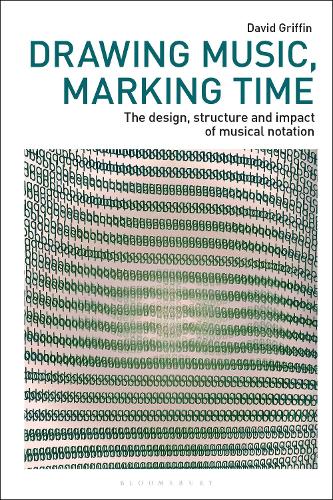
Drawing Music, Marking Time: The design, structure and impact of musical notation
(Hardback)
Publishing Details
Drawing Music, Marking Time: The design, structure and impact of musical notation
By (Author) Assistant Professor David Griffin
Bloomsbury Publishing PLC
Bloomsbury Visual Arts
20th March 2025
United Kingdom
Classifications
Professional and Scholarly
Non Fiction
780.26
Physical Properties
Hardback
168
Width 160mm, Height 236mm, Spine 18mm
520g
Description
Marking down the complexities of musical pieces on paper allows them to become portable, shareable, and eminently teachable, but how are the simple geometries of a music notation unfolded into space and time A music notation is an almost impossibly complicated bit of drawing. Calling it a map or a diagram does not quite do the trick. Its tracery supplies mechanisms for planning, composition, analysis, annotation, and performance of music. But how is it that we read that simple, strategic two-dimensional geometry and make such complex, four-dimensional performances In this book David Griffin guides readers to a comprehensive understanding of the structural properties of music notations, with a particular focus on the standard Western staff notation system, looking at composers such as Bach, John Cage, Earle Brown and Stockhausen. Developed over a thousand years ago, the staff notation is a geometrical drawing method using dots and lines on a horizontal timeline for explaining the structure of a musical piece. The system behaves a bit like a picture, but it is also like a diagram, and a bit like writing in its structure. In the hands of an experienced user, the notations complex of marks and phatic elements allows us to leave behind the mere denotation of diagrams or pictures to become a connotative drawing system. This book will attempt to de-code music drawings, untangling their strange knots of graphic and linguistic elements. Using a series of visual examples, Griffin presents background information on how the staff notation developed as an inter-linguistic inscription, a drawing that slips through the mere denotation of pictorial or diagrammatic graphics to become a connotative system, with which we may craft subtle and powerful elements of musical poetry.
Reviews
We hear music; we see images. Musicians read staff notation as the rest of us read pictures and we take such complex literacies visualcies is a better word - for granted. This book takes them apart; jolting our complacency by exploring the possibilities of alternative visual notation systems designed to bridge that sensory gap between hearing and seeing. A pioneering study of the graphic possibilities for the visual representation of music. * Howard Riley, University of Wales Trinity Saint David, UK *
Author Bio
David Griffin is Assistant Professor at OCAD University in Toronto, Canada. Born in Kingston, Jamaica, he holds a PhD from the Glasgow School of Art, an MFA from the Pratt Institute, and BFA from Parsons School of Design in New York.
